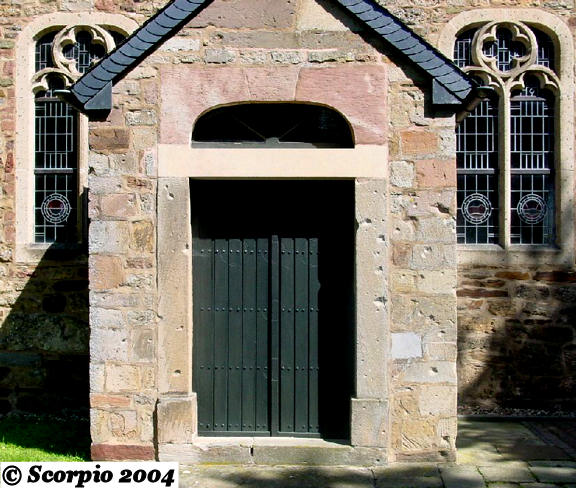
Timeframe: 12/6/1944 - 12/15/1944
The Bergstein Campaign
The enemy was able to direct observed fire from three sides of the perimeter, employing 88's, 75-mm SP's and 120-mm mortars. Tree and ground bursts inflicted the extreme casualties of the operation at this time.
The captured enemy bunker just off the crest of the hill was turned into a First Aid Point. During the subsequent counterattacks, direct fire was laid on the shelter entrance and, at times, the attacking enemy forces advanced so close that it was necessary to shoot one's way out of the bunker in order to reach your assigned defensive position.
Evacuation to the Clearing Station at the Forward CP could be carried on only during the infrequent quiet periods by litter-teams from Companies D/E/F. Litter-Jeep, three of which were destroyed during the action, transported the casualties to the ambulance point at Brandenberg for transmittal to the nearest Collecting Company at Kleinhau. Due to the wrecked vehicle road block between Bergstein and Brandenberg, it was necessary to hand-carry the litters the last three hundred years to the waiting ambulance.
Five counterattacks, each approximately 150 strong and all supported, by intensive mortar and artillery preparation, struck the force on the hill during the forty hours of occupation. The first counterattack, following the devastating barrage, came from the South-east at 0930. The woods in this sector covered the enemy's advance and, in some instances, the attack was discovered just as the enemy was about to rush in the last few hundred years to the bunker. When close in, the enemy would use MG's, s/a, and grenades. Bayonets and hand-to-hand fighting repulsed the near-in enemy, s/a and grenades took care of those further away, while a curtain of artillery fire which continued to grow in intensity caught them coming and going. In this initial attack, S Sgt Secor of Company D, his own weapon smashed into uselessness, turned the tide of the battle when, with a captured machine pistol under each army, he stood up to turn twin streams of demoralizing fire upon the close in enemy.
Artillery concentrations were plotted to cover the critical zones with the fire adjusted by the troops on the hill and the 5th Armd Division FO performed superior service in placing the fire where it was wanted. At times, due to the nearness of the enemy approach, the troops called for fire almost on their positions. The excellent artillery fire was an important factor in the successful holding of the Hill.
At 1242, Captain Slater, returning to the Battalion. CP, reported that only 17 men of Company F and 15 men of Company D were still in fighting, condition. Additional Battalion Medics went forward to assist in the casualty treatment. A patrol from Company D searched the 088338 area for a tunnel reported by the CG 8th Division, returning at 1300 without success. The second attack came from the North-east at 1450, penetrating to within 100 yards of the Forward CP before it was stopped by s/a fire. The enemy artillery fire continued to be intense. The solid masonry of the church withstood 82 direct hits, only one of which penetrated, coming thru one window and glancing out another, causing two casualties from the resulting stone fragments.

Although the church was rebuild after the war, some parts were re-used.
Notice the impact holes in the masonry.
At 1606, the following message was received from the one remaining officer of Company D:
"Counterattacks on hill all afternoon; very heavy artillery; only 25 able-bodies men left; help needed badly; are surrounded".
The reserve platoon of Company C was alerted and a request was sent to the CG 8th Division for reinforcements. The Hill was ringed to the North-east, East and South-east with additional artillery concentrations. An urgent call for help from the Hill at 1652 resulted in the reserve platoon of Company C being rushed immediately into action. The attacking enemy force withdrew in the face of these on-rushing reinforcements and, at 1735, the report was received:
"Everything is quiet on the hill".
Litter parties immediately commenced evacuation from the bunker and, by 2140, all casualties were at the Church Clearing Station. The litter-Jeep was kept busy all night and far into the next day. Cpl Korb of the Medical Detachment voluntarily drove this vehicle during daylight hours even though the enemy fire in this area did not respect the Red Cross.
Companies A/B/C, remaining in position, were shelled internittantly throughout the day. The Battalion CP location was a prime enemy mortar target, being subjected to concentrations at various intervals. The guides which had been stationed in Brandenberg since 0500 brought in the first of the seven TD's at 1913 Two were sent to Company A, two to Company C, and three to Company E. The pending relief of Company A by Company K/28th Infantry was effected at 2100; Company A then returning to defensive positions in Bergstein, by platoons. The only enemy activity during the relief process consisted of several flares and the normal harassing artillery fire. One platoon of Company A picked up the 28 prisoners from the Forward CP, the Battalion total for this day. After processing at the Battalion CP, the prisoners were delivered to the 47th AIB in Brandenberg. Rations, water, ammunition, mortars, and LMG's were brought in by the Battalion Supply Vehicles at 2345. Division Engineers also arrived at this time to lay hasty minefields in the Companies B/E areas.

